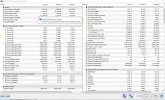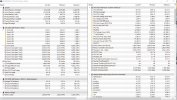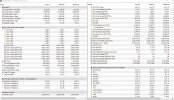First of all, I want to say its not a rant against this great piece of software that HWINFO is, obviously
I have been OCing since the days of the Intel G3258 and always used fixed voltage to proceed, being on a 4670k afterwards, a Ryzen 1500X 3 yrs ago and now the 3500X I am using on my main Gaming rig
For some reason this weekend I decided to test a Voltage offset feature in my MB, the ASROCK B550M Steel legend. So far I had 3 OC/UV preset I had tested in and out as stable in benchmark and heavy gaming. all these OC were set in Ryzen Master, not in the BIOS
the 1st run in the pic below is just leaving Voltage in AUTO in the BIOS and run CB R23 to get temps and Voltage readings monitoring on focus
CPU boosting to 4,1Ghz so normal, CPU Voltage SVI2, CPU Core VID effective and Vcore all giving me same reading around 1.36/1.38V with a Max CPU power package around 72W and temps in low 70s, again nothing to worry about in my views, well within the chip limits

the 2nd run so I did to test the Offset Voltage feature was a -100mV in the OCtweaker section in the BIOS and boot into Windows
same testing with CB R23 and to my surprise, CPU Voltage SVI2, CPU Core VID effective were not affceted by the offset voltage, only the Vcore saw a decrease
all temps, power consumption were actually positively affected by the change too

then final run, while in Windows, I applied an OC which is to boost all core 4.1Ghz @1.23V demand in Ryzen Master
in that case, CPU Voltage SVI2, CPU Core VID effective were reflecting my demand Voltage but the Vcore dropped to 1.13V basically applying, at least that's my understanding, the Ryzen Master voltage minus the 100mV that I set in the BIOS as Offset voltage

I have always read that the CPU Voltage SVI2, CPU Core VID effective were the ones Voltage to believe the CPU was actually getting so I am little bit confused now and looking for someone who could bring some clarity here
Maybe that's an ASROCK BIOS thing or the normal behaviour of these 3000series Ryzen or maybe me doing the wrong assessment, so again not a rant at all against HWINFO readings, its just me trying to understand a phenomena to be in better control of my Rig
thanks so much
I have been OCing since the days of the Intel G3258 and always used fixed voltage to proceed, being on a 4670k afterwards, a Ryzen 1500X 3 yrs ago and now the 3500X I am using on my main Gaming rig
For some reason this weekend I decided to test a Voltage offset feature in my MB, the ASROCK B550M Steel legend. So far I had 3 OC/UV preset I had tested in and out as stable in benchmark and heavy gaming. all these OC were set in Ryzen Master, not in the BIOS
- All core OC 4.1Ghz @1.13V
- All core OC 4.4Ghz @1.2375V
- All core OC 4.5Ghz @1.35V
the 1st run in the pic below is just leaving Voltage in AUTO in the BIOS and run CB R23 to get temps and Voltage readings monitoring on focus
CPU boosting to 4,1Ghz so normal, CPU Voltage SVI2, CPU Core VID effective and Vcore all giving me same reading around 1.36/1.38V with a Max CPU power package around 72W and temps in low 70s, again nothing to worry about in my views, well within the chip limits

the 2nd run so I did to test the Offset Voltage feature was a -100mV in the OCtweaker section in the BIOS and boot into Windows
same testing with CB R23 and to my surprise, CPU Voltage SVI2, CPU Core VID effective were not affceted by the offset voltage, only the Vcore saw a decrease
all temps, power consumption were actually positively affected by the change too

then final run, while in Windows, I applied an OC which is to boost all core 4.1Ghz @1.23V demand in Ryzen Master
in that case, CPU Voltage SVI2, CPU Core VID effective were reflecting my demand Voltage but the Vcore dropped to 1.13V basically applying, at least that's my understanding, the Ryzen Master voltage minus the 100mV that I set in the BIOS as Offset voltage

I have always read that the CPU Voltage SVI2, CPU Core VID effective were the ones Voltage to believe the CPU was actually getting so I am little bit confused now and looking for someone who could bring some clarity here
Maybe that's an ASROCK BIOS thing or the normal behaviour of these 3000series Ryzen or maybe me doing the wrong assessment, so again not a rant at all against HWINFO readings, its just me trying to understand a phenomena to be in better control of my Rig
thanks so much


